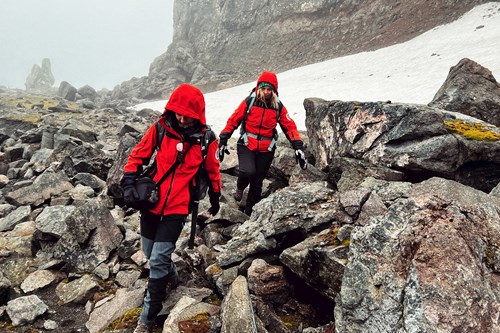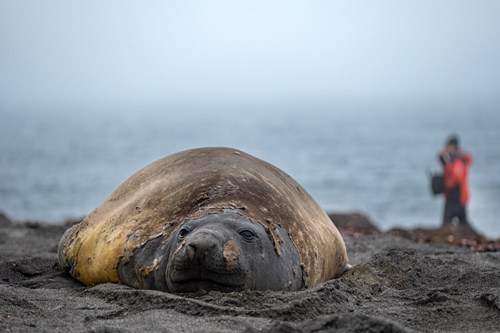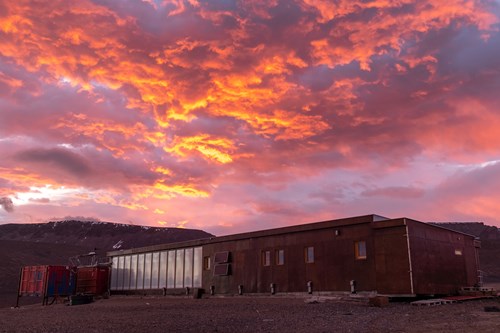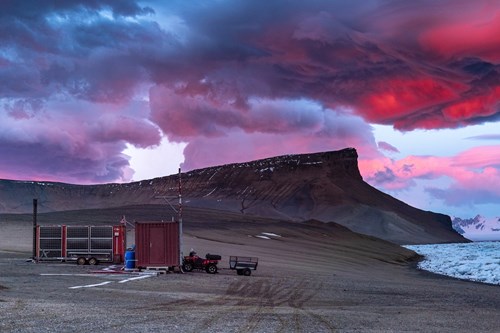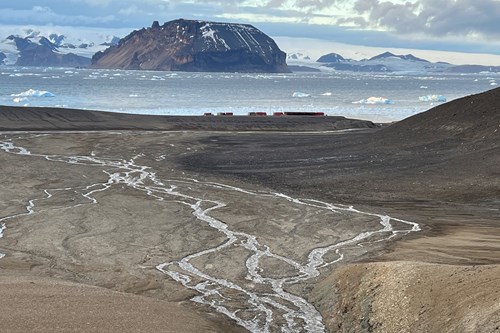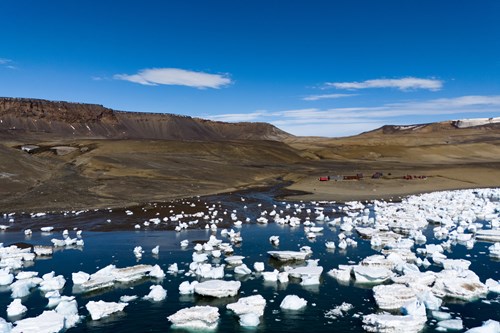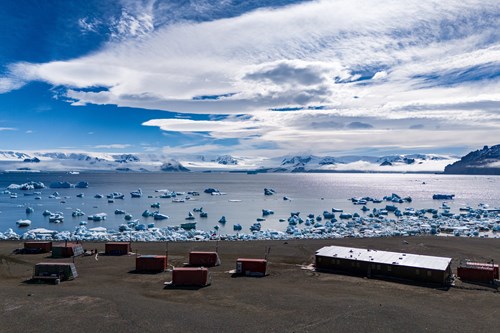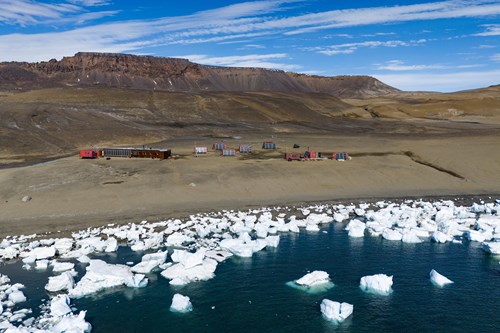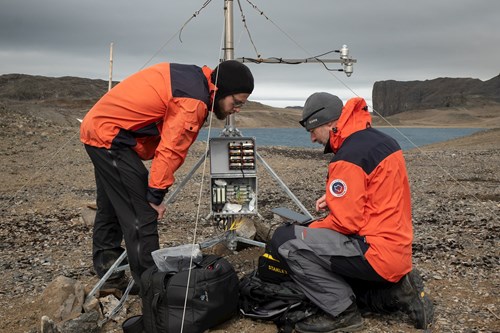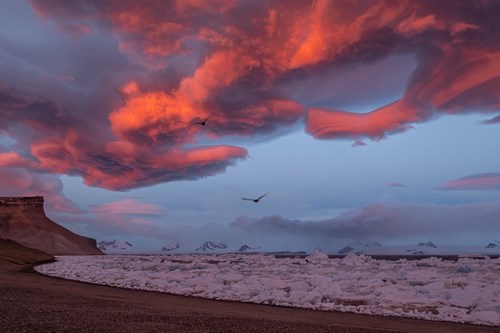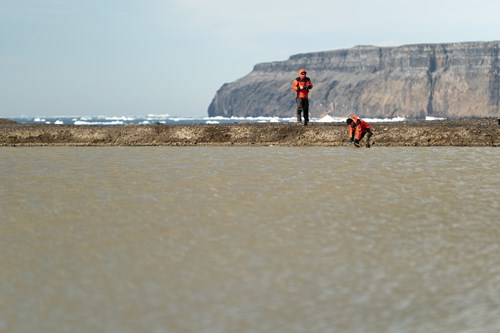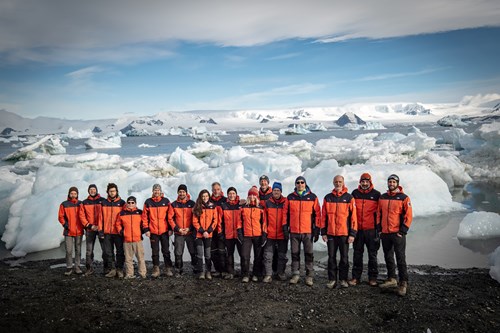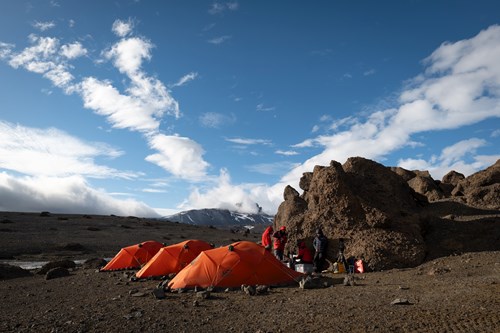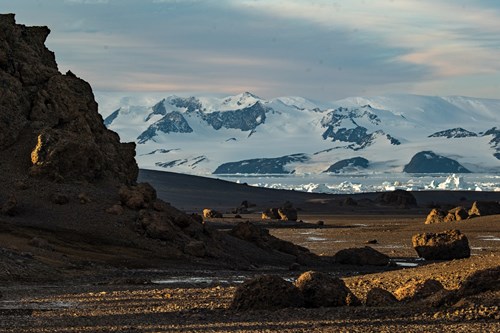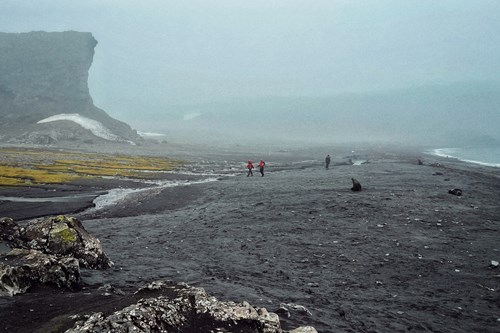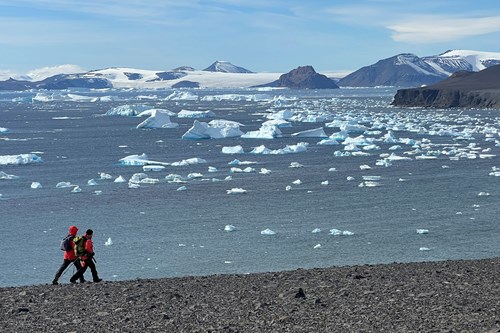This year’s expedition lasted a total of 59 days, out of which the researchers spent 17 days at the J.G. Mendel station on James Ross Island, plus six days on King George Island. This is the shortest period spent in Antarctic terrain out of the 20 expeditions so far. “This was the result of logistic complications caused mainly by weather conditions and the amount of sea ice around James Ross Island. First, a storm raged over the Drake Strait, followed by a breakdown in the ship that was supposed to transport the expedition to the site, then there was a significant amount of ice around the island, which made both the disembarkation and subsequent return of the expedition unsafe”, explained expedition leader Peter Váczi from the Departments of Geography and of Experimental biology at the MU Faculty of Science.

Navigation around James Ross Island was complicated by a large amount of sea ice. Photo: Petr Horký.

Navigation around James Ross Island was complicated by a large amount of sea ice. Photo: Petr Horký.
Throughout these difficulties, the international community of scientists and collaborators in the Antarctic region once again cooperated wonderfully. When it proved impossible to continue to James Ross Island by ship, for example, our Turkish colleagues helped move seven of our polar explorers to King George Island by air, where they awaited the arrival of the remaining nine members at the Artigas Base (Uruguayan national research programme), all 16 members of the expedition later sailing to James Ross Island on a ship supplied by the Chilean Air Force. Around the same time, the first part of this year’s expedition returned from Nelson Island, with logistic support supplied through the Brazilian and Chinese research programmes. “As a result, our scientists had the opportunity to establish new cooperation with neighbouring national scientific programmes and carry out essential inspections and maintenance of automatic meteorological and climatological measuring stations. Cooperation and capacity-sharing across nations in Antarctica works fantastically, and we are very grateful to all the colleagues and supporting programmes involved”, emphasised Pavel Kapler, manager of the Czech Antarctic Research Program.

This year's expedition was made difficult by weather conditions, especially strong wind. Photo: Petr Horký
Even after moving to James Ross Island, the level of sea ice prevented disembarkation at the station drop-off point, meaning that the expedition and all its material had to be moved to the station from a temporary wharf using all-terrain four-wheelers. Even their departure did not go according to plan. Meteorological forecasts from our Chilean colleagues and continuing build-up of sea ice suggested that conditions for the return journey were becoming worse. Consequently, the Chilean Navy were sent to pick up the expedition members and transport them back on March 3, about a week earlier than the original plan.

As every year, long-term climate monitoring and comprehensive monitoring of the state of polar geosystems and ecosystems took place in Antarctica. In the picture, Michael Matějka and Kamil Láska from the Institute of Geography, Faculty of Economics, MU. Photo: Petr Horký.
Despite the short stay, the 16-member Masaryk University expedition team managed to complete most of the most-important projects they set with this year. “We always set out with more work planned for the expedition than time allow. Even this year, despite all the difficulties, we managed to complete the most important things, and above all, ensure long-term monitoring of the natural environment and climate”, said Daniel Nývlt, head of the Czech Antarctic Research Program.

Katarína Adameková from the Institute of Geography and the Institute of Geological Sciences of the MU Faculty of Science and Lucia Kaplan Pastíriková from the MU Faculty of Geography institute focused on geomorphological research in the field. Photo: Petr Horký.
In addition to fulfilling their standard scientific and technical tasks, our scientists, in cooperation with the Chilean Antarctic Institute (INACH), confirmed the occurrence of a highly infectious bird flu virus (strain H5N1) at the site. “We noticed that five of the roughly fifty south polar skuas nesting in the vicinity of the station had died, i.e. roughly 10% of the population found on the ice-free part of James Ross Island”, said biologist Miloš Barták, who was the first to report the suspicious deaths and took samples for analysis in cooperation with Chilean colleagues. His suspicions of bird flu were confirmed by the laboratory at the Chilean Escudero station on King George Island. Scientists agree that migratory bird species, such as skuas and storm-petrels, were the most likely carriers of the disease. The greatest danger now is the potential transmission of this virus to penguins. This is unlikely in the vicinity of the Czech station, however, as there is no resident colony of penguins.

ATVs are also important helpers for moving material or samples. Photo: Petr Horký.
The goal of this year’s expedition was, as always, long-term climate monitoring and comprehensive monitoring of the state of polar geo- and ecosystems, i.e. glaciers, long-term frozen soils, deglaciated areas enabling the growth of lower plants, river and lake systems and other geomorphological formations. The five-year JUNIOR STAR project, which began in 2022, continues its study of changes in the long-term frozen soils of the Antarctic Peninsula, as does medical-psychological research into the effect of stress on the health of workers in polar regions, undertaken in collaboration with Ostrava Faculty Hospital, the MU Faculty of sports studies and the Czech Academy of Sciences.

A team of 16 scientists spent 17 days at the polar station this year, the shortest stay so far during the expeditions. Photo: Petr Horký.
As part of the Czech Antarctic Research Programme’s ongoing cooperation with industry and the application sphere, testing continued on auxiliary equipment for the automatic meteorological station provided by the company COMET SYSTEM, along with further testing of safety equipment manufactured by the company SCILIF (Wearable Active Lighting Technology SUNFIBRE®) and outdoor socks manufactured by Northman of Bruntál, both of whom are applying for a license to use the ‘Tested in Antarctica’ trademark. The user tests performed will be evaluated by the MU Technology Transfer Centre, shortly after the expedition returns.
The Czech J. G. Mendel Science Station, owned and operated by Masaryk University, was completed on March 4, 2006. It was ceremonially opened and handed over to scientists for use on February 22, 2007. A second base, formerly known as Eco-Nelson, is located on Nelson Island in the South Shetland archipelago and now serves as a technical-logistic refugium under the name CZ*ECO Nelson as part of the research programme infrastructure. The building was acquired from a private owner by the Czech Antarctic Foundation, which has been leasing it to Masaryk University under a 99-year lease since 2018.
Photogallery
Photo: Petr Horký, MU Archive.









